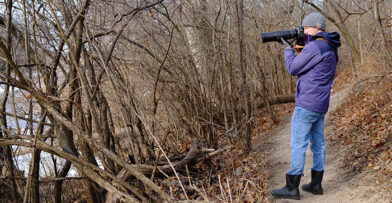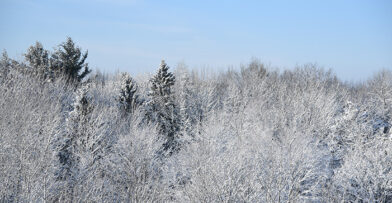In the frigid winter months, how do animals survive? Reptiles and amphibians brumate all winter long, sleeping through the harshest of freezing weather, while many species of birds migrate south in search of food and water. However, not all animals can sleep or fly away. For mammals that stay active all winter long, a key adaptation to their survival is their fur.
Although the word fur is typically used for non-human mammals, we are referring to hair, which all mammals, including humans, have. All hair is made from a protein called keratin, but there are three types of hair with different purposes. The first, vibrissae, is designed to help an animal sense their surroundings, like whiskers on a cat. The second, ground hair, helps with thermoregulation. Finally, the guard hair is meant to protect the ground hair and skin from the outside elements.
The Adaptable Fur of White-Tailed Deer
As the seasons change in Wisconsin, the fur of a few mammals also goes through a change. One of our most common mammals, the white-tailed deer, has this change twice a year. In summer, their fur is red in color with short guard hair and no ground hair. Even though there are twice as many guard hairs in their summer fur than there are in their winter fur, without the ground hair, there is much more air flow to keep the deer cool during the hottest days. The guard hair mainly protects the deer from the sun as well as from bugs that would want to bite them.
Once the weather cools off, the deer grow their winter coat, which contains a thick, woolly layer of ground hair and long guard hair. The ground hairs are soft and twist around to create pockets of air close to the skin, making insulation. The guard hairs are hollow, which not only adds an extra layer of insulation, but also protects the underfur from cold, wet snow. Besides a textural change in their fur, there is also a change in color. The winter fur is gray to dark brown, which absorbs more sunlight and helps keep the deer warm.
Dramatic Changes of the Weasel
Another animal that changes their fur color for winter is the weasel, of which there are three types in Wisconsin. This animal has a more dramatic change in color, which not only helps it hide from their prey, but more importantly helps them escape from their predators! In summer, they have a dark brown coat with a white to pale yellow stomach, which helps them blend in with the forest floor. As winter approaches with the promise of snow, the weasels will shed their brown summer coat and start growing a white winter coat.
However, not all the fur on their body goes through a change. The weasels have a black tip of fur at the end of their tail to help distract predators. If there is an owl or a hawk that is hunting the weasel, the predators are more likely to see the black tip of the tail as the weasel is moving. Once this predator dives down for their prey, they could capture the black tip which would just be a small amount of fur, while the rest of the creature escapes. On the other hand, the weasel easily switches roles to become the predator by camouflaging in its surroundings and sneaking up on its prey, including another active Wisconsin mammal, the muskrat.
The Adaptations of Muskrats
The muskrat is a semi-aquatic creature that has many predators, and to escape it swims away, even when there is ice covering the ponds. Since it uses this defense year-round, it doesn’t need to change its fur. To keep themselves from freezing in the water, most of their body is covered with densely packed ground hair and waterproof guard hair. Their feet and tail, which are not covered in fur, go through a process called regional heterothermia, which keeps those parts cool to conserve energy. This combination is essential to their survival as they escape predators and forage for food under the ice.
Though all mammals have some form of fur, Wisconsin mammals have adaptable fur with many unique attributes to help them survive in winter. Whether it’s hollow hair, waterproof hair, or changing the color of their hair, their fur will help them survive until the warmth of spring.


